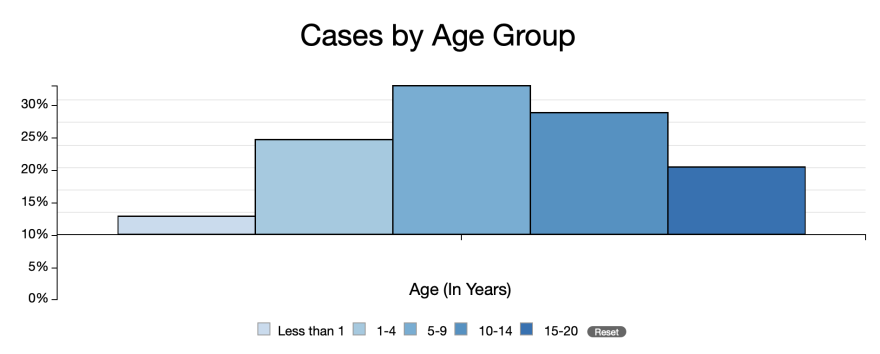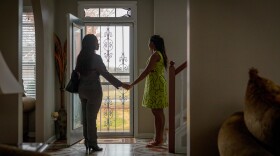At Riley Children’s Hospital in Indianapolis, Dr. Samina Bhumbra has been receiving calls for help from health centers across the state. Callers describe children with symptoms such as high fever, red eyes, swollen lips and abdominal pain.
To Bhumbra, an assistant professor of clinical pediatrics, that can point to a potentially fatal condition known as MIS-C. It’s rare, but appears to be increasing with every COVID surge.
Multisystem Inflammatory Syndrome in Children has become all too familiar to Riley’s specialists. They’ve seen dozens of cases.
“It's still a very rare phenomenon today,” Bhumbra says. “There have been about three million COVID cases in children since the beginning of the pandemic. But really, about 2,000 children have been diagnosed with MIS-C.”
The condition is characterized by severe inflammation that affects organs like the heart and lungs. MIS-C can happen during a COVID infection or weeks later — even when a child hasn’t shown symptoms of the virus.
At least 33 children have died nationwide.
MIS-C affects every child differently, and doctors are unsure why some develop it and others don't. But they say it’s hitting Black and Latinx children especially hard.
“Just like with COVID-19 impacting minority populations, we have seen that pattern with MIS-C as well,” Bhumbra says.
CDC data shows that 2,617 children got MIS-C nationwide and 69% are Black or Latinx.
Kendrick Moore, a 9-year-old who lives north of Chicago, got MIS-C last March — one of the nation’s first cases.

“Since then, I’ve been pretty famous,” he says.
Kendrick paid a big price for that fame. When he developed MIS-C, his heart was failing, and so were his kidney, liver and pancreas. He spent 12 days in an intensive care unit at Lutheran General Hospital.
Almost a year has passed since he got home. But his mom, Samantha Geer, says he’s still battling some lingering effects.
“We first noticed the brain fog. … he doesn't complete a full task,” she says. “Almost all of his hair fell out. It was coming out in clumps. And then the headaches started. And then there'll be a random stomach ache here or there.”
MIS-C’s long-term effects are still unknown, and doctors are especially worried about the impact on the heart. They recommend that patients follow up with various specialists for up to a year or more.
Kendrick sees a cardiologist, infectious disease specialist and a neurologist. Doctors also say he needs to see a neuropsychologist to help with the trauma; part of it comes from being poked and stuck over and over.
His mom says going to the doctor’s office is a trigger for him now.
“At any doctor's appointment his first question is, 'Do I need a blood test?'” Geer says. “He had a central line through his groin. He had an arterial line and he had all the IVs from that first day that got the veins so sore and blown.”
But being on a Medicaid plan meant that none of the neuropsychologists within 75 miles would accept Kendrick’s insurance. And the only doctor she found has more than a year’s wait for an appointment. It’s yet another disparity that puts many low income Black and Latinx kids at a disadvantage.
“It's so beyond frustrating and then again, they're the kids who are not going to be able to get the follow up care because of the neighborhoods they're living in,” Geer says. “It's not fair. He didn't choose this.”


And it’s not just the post-COVID inflammation that Black and Latinx kids struggle with. A nationwide study published in JAMA suggests that if they contract the virus, they are also more likely to suffer from severe COVID symptoms.
Doctors and researchers are trying to figure out why kids react differently to COVID.
Dr. Courtney Rowan, an associate professor who works in Riley’s pediatric ICU, participated in the nationwide study. She and other doctors are trying to understand this disparity by looking at a multitude of factors.
“Is there something in your genetic profile that makes you more predisposed to have bigger inflammatory reactions or to get sick or when you're exposed to this particular virus?” Rowan says. Or it could be tied to social and economic factors.
Even before the pandemic began, Black children suffered from many health disparities. For example, they are nearly twice as likely to have asthma, even when adjusting for income and family characteristics.
Rowan says getting vaccinated is the only way families can protect their children — especially those in vulnerable populations.
“Our children are not able to be vaccinated right now, there's not a vaccine that exists ... " Rowan says. "And I think that these racial disparities that we're seeing within COVID and COVID-related illnesses really hammer home the need to make sure that we're providing access to the vaccine across all social and racial populations within the state.”

Angela Bass, a Black mother of two in Jackson, Mississippi, had to take her 5-year-old son to the hospital three times before he was admitted. It all started with a fever, stomach pain and vomiting. When he also developed a rash, she knew from what she read online that she had to take him to the ER.
“As his mom, I could sort of see like the rash was bubbling up on his stomach, but his skin is dark," Bass says. "And so you know, the doctors were kind of looking at me like ... 'Are you sure it's a rash there?' ... And I really had to sort of like push for more testing. ... I started naming things like, 'Could it be MIS-C?'”
Testing showed that his organs were showing signs of severe inflammation. At that point, doctors started treatment right away.
The boy stayed in the hospital for 15 days, four of them in the ICU. He went back home and had to take a course of steroids. Now he takes aspirin to limit blood clotting.
Bass says because this disease is relatively new and symptoms can be mistaken for other mild conditions at first, she had to advocate for the proper care.
"If you're a parent and you feel like something is not right ... just continue to push and just know the signs,” Bass advises parents. “And go to a children's hospital if you can, because they all know more about how to treat it.”
This story was produced by Side Effects Public Media, a news collaborative covering public health.






